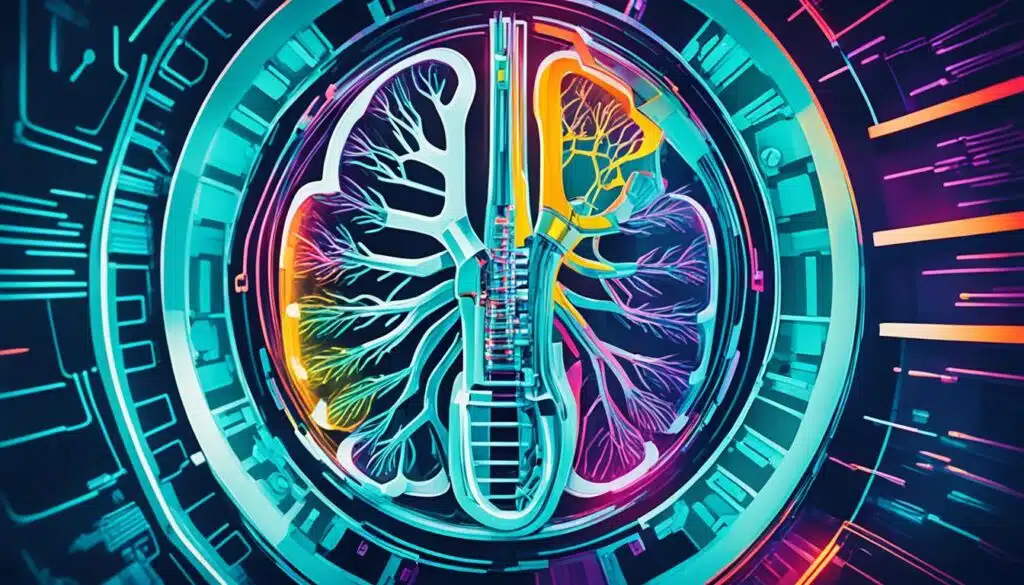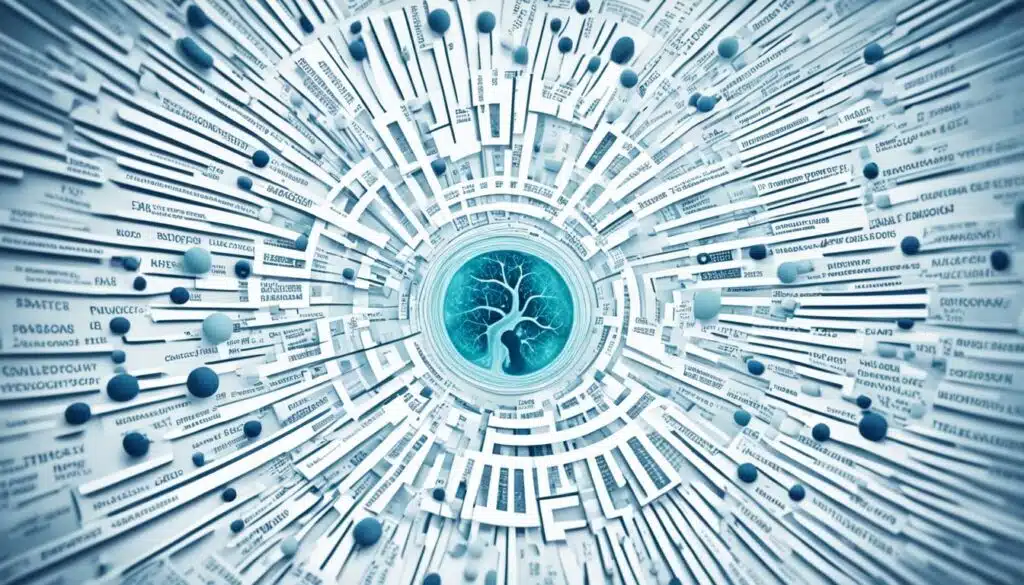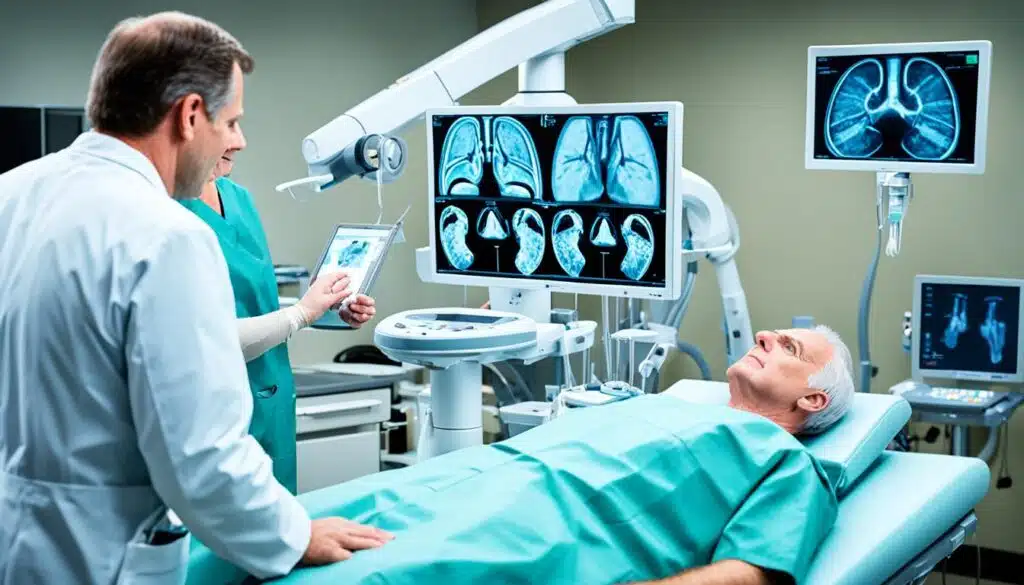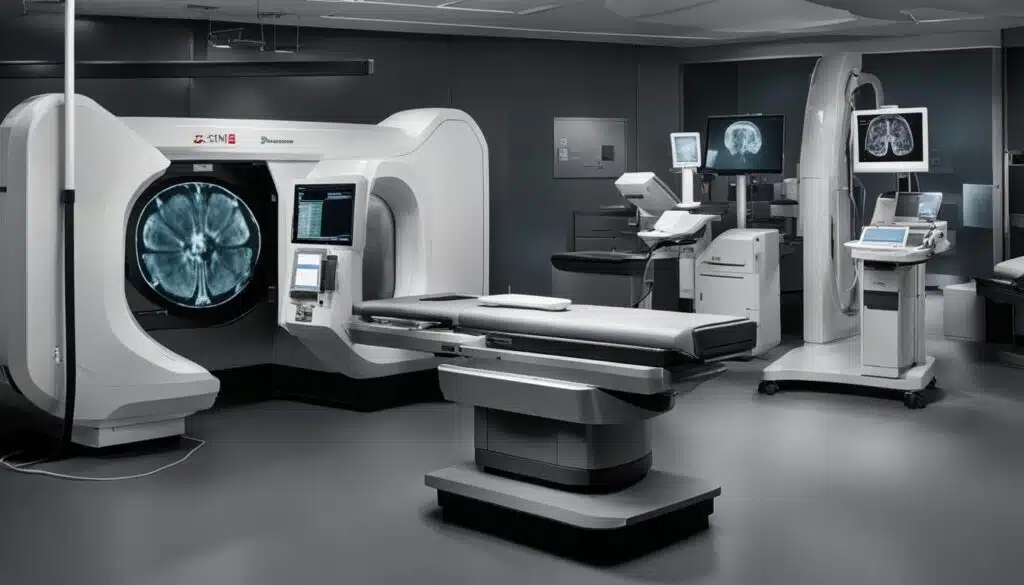Diving Into Radiology is a vital medical discipline that plays a crucial role in modern healthcare. Radiologists specialize in diagnostic imaging, using techniques such as X-rays, CT scans, and MRI to visualize and identify abnormalities in the human body. They work closely with other healthcare professionals to provide accurate diagnoses and guide treatment plans. The field of radiology offers extensive training opportunities and covers a wide range of medical conditions and diseases.
Key Takeaways:
- Radiology is a vital medical discipline that utilizes various imaging techniques to visualize and identify abnormalities in the human body.
- Radiologists work closely with other healthcare professionals to provide accurate diagnoses and guide treatment plans.
- The field of radiology offers extensive training opportunities and covers a wide range of medical conditions and diseases.
- Technological advancements in radiology, such as AI and digital imaging, continue to improve diagnostic accuracy and patient care.
- Radiology plays a crucial role in patient care, contributing to personalized medicine and improved outcomes.
The Role of Radiology in Medicine
Radiology plays a crucial role in the screening, diagnosis, and management of various medical conditions. In the field of medicine, radiologists are the experts who interpret medical images to identify and assess diseases or injuries in different parts of the body. Using advanced imaging techniques such as CT and MRI scans, radiologists play a vital role in patient care by providing accurate diagnoses and guiding treatment plans.
Radiology involves the use of imaging technology to visualize the internal structures of the body. This allows radiologists to detect abnormalities, analyze the extent of disease or injury, and monitor treatment progress. Radiologists work closely with physicians to provide comprehensive evaluations, contributing to the overall management of diseases.
Radiology fellowship programs provide extensive training and specialization opportunities for aspiring radiologists. These programs enable radiologists to focus on specific areas of expertise, such as abdominal or neck imaging. By honing their skills and knowledge in these subspecialties, radiologists contribute to the accurate diagnosis and efficient management of diseases.
One of the key techniques used in radiology is Computed Tomography (CT). CT scans create detailed cross-sectional images of the body using a combination of X-rays and computer technology. This imaging technique is particularly useful for evaluating the abdomen, chest, and other internal structures. Another essential imaging modality is Magnetic Resonance Imaging (MRI), which uses powerful magnetic fields and radio waves to generate detailed images. MRI scans are commonly employed to visualize the brain, spine, and other soft tissues.
By playing a pivotal role in the interpretation and analysis of medical images, radiologists provide essential insights for physicians and other healthcare professionals. Their expertise enables accurate diagnosis, guides treatment decisions, and contributes to improved patient outcomes.
| Benefits of Radiology | Key Areas of Practice | Crucial Contribution |
|---|---|---|
|
|
|
The Subspecialties of Radiology
Radiology encompasses various subspecialties, allowing radiologists to develop expertise in specific areas. These subspecialties offer unique opportunities for specialization within the field of radiology, catering to different patient populations and medical conditions. Let’s explore some of the key subspecialties:
Pediatric Radiology
**Pediatric radiology** focuses on imaging children, from newborns to adolescents. Radiologists in this subspecialty have specialized training in interpreting and performing imaging procedures for pediatric patients. They work closely with pediatricians and other healthcare professionals to ensure accurate diagnoses and effective treatment plans.
Neuroradiology
**Neuroradiology** specializes in the imaging of the brain, spinal cord, and peripheral nerves. Radiologists in this field use advanced imaging techniques such as MRI and CT scans to diagnose and treat neurological conditions, including strokes, brain tumors, and spinal disorders. Their expertise is crucial in guiding neurosurgeons and neurologists in providing optimal patient care.
Interventional Radiology
**Interventional radiology** involves minimally invasive procedures that are guided by imaging techniques. Radiologists who specialize in this subspecialty use various imaging modalities, such as fluoroscopy, ultrasound, and CT scans, to perform procedures such as angioplasty, embolization, and tumor ablation. Interventional radiology techniques offer patients less invasive alternatives to traditional surgical procedures.
Pathology
In the field of radiology, **pathology** refers to the interpretation and analysis of imaging studies related to the detection and characterization of disease processes. Radiologists with expertise in pathology work closely with pathologists to correlate imaging findings with tissue analysis, aiding in the diagnosis and staging of cancers and other diseases.
Chest Radiology
**Chest radiology** focuses on the imaging of the chest and its surrounding structures, including the lungs, heart, and mediastinum. Radiologists in this subspecialty use various imaging techniques to diagnose and monitor conditions such as lung cancer, pneumonia, and cardiovascular diseases. Their expertise contributes to the accurate diagnosis and management of chest-related disorders.
Musculoskeletal Radiology
**Musculoskeletal radiology** specializes in imaging the bones, joints, muscles, and surrounding soft tissues. Radiologists in this subspecialty play a critical role in diagnosing and treating bone and joint conditions, including fractures, arthritis, and sports injuries. Their expertise helps orthopedic surgeons and other healthcare professionals develop appropriate treatment plans for patients.
These subspecialties demonstrate the diverse and dynamic nature of radiology, catering to specific medical needs and patient populations. Each subspecialty requires additional training and expertise to provide the highest level of care and contribute to the advancement of medical imaging.
The Advancements in Radiology Technology
The field of radiology has experienced remarkable advancements in technology, revolutionizing diagnostic accuracy and patient care. These advancements are driven by the integration of artificial intelligence (AI) into radiology practice and the development of advanced imaging techniques. By employing AI algorithms and leveraging digital imaging technology, radiologists can enhance the accuracy and efficiency of diagnoses, leading to improved patient outcomes.
The Role of AI in Radiology
Artificial intelligence has emerged as a powerful tool in radiology, enhancing diagnostic capabilities and streamlining workflows. AI algorithms can analyze vast amounts of imaging data within seconds, assisting radiologists in the identification of abnormalities and providing suggested diagnoses. By harnessing machine learning techniques, AI algorithms continuously improve their diagnostic accuracy over time, enabling radiologists to make more informed decisions. This integration of AI in radiology has shown promising results in improving detection rates and reducing medical errors.
AI technology also enables automated image processing and data extraction, allowing radiologists to focus on interpreting complex cases and making critical decisions. By automating repetitive tasks, AI frees up valuable time for radiologists to provide personalized patient care and engage in more complex diagnostic processes.
Advanced Digital Imaging Techniques
Digital imaging techniques have transformed the field of radiology, enabling faster and more efficient image acquisition, interpretation, and storage. With the advent of digital imaging, traditional film-based methods have largely been replaced, offering numerous advantages in terms of image quality, accessibility, and archival. Digital imaging allows for real-time image display, manipulation, and analysis, empowering radiologists to make more accurate and detailed assessments.
Furthermore, digital imaging facilitates the seamless integration of imaging data into electronic health records (EHRs) and allows for the sharing of images between healthcare providers, enhancing collaboration and interdisciplinary communication. This digital transformation has greatly improved the efficiency of radiology departments, enabling faster access to images, easier retrieval of past studies, and improved patient communication and engagement.
The Future of Radiology Technology
The advancements in radiology technology continue to propel the field forward, with ongoing research and development paving the way for even more exciting innovations. The future of radiology holds great promise in areas such as precision medicine, where imaging techniques will play a vital role in tailoring treatments to individual patients based on their unique characteristics. Additionally, as AI continues to evolve, radiology will see further advancements in decision support systems, image analysis algorithms, and automation of routine tasks.
Summary of Advancements in Radiology Technology
| Advancements | Description |
|---|---|
| Artificial Intelligence (AI) | Integration of AI algorithms into radiology practice, assisting in diagnosing abnormalities and providing suggested diagnoses. |
| Digital Imaging | Advanced techniques that enable faster image acquisition, improved image quality, and seamless integration of imaging data into electronic health records. |
The advancements in radiology technology have ushered in a new era of diagnostic accuracy and patient care. With AI-driven tools and digital imaging techniques, radiologists can provide more precise and efficient diagnoses, leading to improved outcomes for patients. As technology continues to evolve, the future of radiology holds even more exciting possibilities, ensuring that the field remains at the forefront of medical innovation.
The Radiology Curriculum in Medical School
Medical schools recognize the crucial role of radiology in modern healthcare and have integrated comprehensive radiology curricula into their educational programs. This ensures that future physicians acquire a strong foundation in medical imaging and the skills necessary to effectively utilize this vital diagnostic tool.
The radiology curriculum within medical schools incorporates a multifaceted approach to education, combining didactic lectures, clinical rotations, and hands-on training in interpreting and analyzing imaging studies. These diverse learning methods provide students with a well-rounded understanding of the field, preparing them for real-world applications and challenges.
Recognizing the need for flexibility and accessibility, several medical schools now offer online courses in radiology. These courses provide students with the opportunity to enhance their knowledge and proficiency in medical imaging at their own pace. Online learning platforms have become a valuable resource, facilitating global accessibility to radiology education and enabling students to access high-quality training materials anytime, anywhere.
One innovative approach to incorporating radiology education in medical school is through vertical integration. This entails integrating radiology concepts and training throughout all years of medical school, ensuring a comprehensive understanding of the field and the seamless integration of radiology knowledge into clinical practice. By immersing students in radiology education from the earliest stages, medical schools foster a deeper understanding and appreciation of its importance in patient care.
To provide a practical context for learning, medical schools often collaborate with radiology departments to offer clinical rotations. During these rotations, students have the opportunity to observe and actively participate in the interpretation of imaging studies, under the guidance of experienced radiologists. This hands-on experience further enhances students’ understanding of radiology’s role in clinical decision-making and patient management.
Advantages of the Radiology Curriculum in Medical School
1. Strengthened diagnostic skills: The radiology curriculum equips medical students with the knowledge and confidence to interpret imaging studies accurately, allowing them to make informed diagnostic decisions in their future practice.
2. Improved interdisciplinary collaboration: Radiology education in medical school fosters collaboration between radiologists and other healthcare professionals, creating a more cohesive and integrative approach to patient care.
3. Enhanced patient safety: By integrating radiology education, medical schools emphasize the importance of quality assurance and patient safety, ensuring that future physicians are well-versed in the proper utilization and interpretation of medical imaging.
4. Global accessibility: The availability of online radiology courses enables students from around the world to access high-quality education materials, allowing for greater global accessibility and dissemination of radiology knowledge.
As medical education continues to evolve, the integration of radiology into the curriculum remains essential. By providing comprehensive and accessible radiology training, medical schools empower future physicians with the necessary skills to leverage medical imaging effectively, thus enhancing patient care and outcomes.
The Impact of Radiology on Patient Care
Radiology plays a crucial role in patient care by providing essential diagnostic information and guiding treatment decisions. Radiologists, along with other healthcare professionals, collaborate in interdisciplinary teams to ensure accurate diagnoses and personalized treatment plans for patients. Through advanced imaging techniques, radiology enables a more precise assessment of diseases and helps monitor treatment response. This interdisciplinary collaboration and integration of radiology into patient care have greatly contributed to improved outcomes and enhanced the practice of personalized medicine.
“Radiology allows us to see inside the human body with unparalleled clarity, enabling us to detect, diagnose, and treat diseases in a targeted and effective manner.”
With their expertise in interpreting various imaging modalities like X-rays, CT scans, and MRI, radiologists provide valuable insights into the underlying pathology and guide healthcare teams in making informed decisions. The accurate diagnosis provided by radiology plays a pivotal role in formulating appropriate treatment plans and monitoring the progress of patients.
Furthermore, radiology has revolutionized the practice of personalized medicine. By tailoring treatment plans to individual patient needs, personalized medicine aims to maximize treatment efficacy and minimize unnecessary interventions. Radiologists play a crucial role in this approach by providing critical information through imaging studies, allowing for precise targeting of therapies and interventions. This collaborative effort between radiology and other medical specialties ensures that patients receive tailored treatments based on their unique characteristics and needs.
Improved Outcomes through Radiology Intervention
The integration of radiology into patient care has significantly contributed to improved outcomes across various medical disciplines. By providing detailed and accurate diagnostic information, radiology helps shorten the time to diagnosis, leading to timely initiation of appropriate treatment. This, in turn, improves patient prognosis and reduces the risk of disease progression.
Radiology also plays a vital role in minimally invasive procedures and image-guided therapies. Interventional radiologists utilize advanced imaging technologies to perform interventions, such as biopsies, vascular procedures, and tumor ablations, with precision and minimal invasiveness. These interventions not only enhance patient comfort but also contribute to better treatment outcomes by targeting specific areas of concern.
Moreover, the use of radiology in monitoring treatment response is crucial for evaluating the effectiveness of therapies and making any necessary adjustments. By providing clear visualization of anatomical structures and pathological changes, radiological imaging enables physicians to assess treatment efficacy in real-time, ensuring that patients receive appropriate and timely interventions.
Overall, radiology’s impact on patient care is multifaceted and invaluable. Through accurate diagnosis, interdisciplinary collaboration, and personalized medicine, radiologists contribute to improved outcomes and enhanced patient experiences. By harnessing the power of advanced imaging technologies and collaborative approaches, radiology continues to pave the way for more efficient and effective patient care.
The Future of Radiology
The future of radiology holds immense potential as technological advancements and innovative approaches continue to shape the field. With the rapid development of artificial intelligence (AI), radiologists can expect more sophisticated algorithms and tools that will aid in image interpretation and diagnosis. This integration of AI technology will enhance the accuracy and efficiency of radiological assessments, ultimately benefiting patients and healthcare providers.
Precision medicine is another important aspect that will drive the future of radiology. By tailoring treatments based on an individual’s unique characteristics, radiologists will contribute to more personalized and effective patient care. The ability to consider genetic, environmental, and lifestyle factors will revolutionize treatment plans, leading to improved outcomes and patient satisfaction.
“The future of radiology lies in the convergence of technological advancements and precision medicine. As we harness the power of AI and integrate it with our growing understanding of personalized medicine, we open doors to new possibilities in diagnosis, treatment, and patient care.” – Dr. Emily Roberts, Radiologist
Ongoing research and collaboration with other medical disciplines will continue to drive innovative breakthroughs in radiology. Radiologists will play a crucial role in multidisciplinary teams, contributing their expertise and insights to advance scientific knowledge and improve patient outcomes. By embracing a research-driven approach, radiologists can push the boundaries of the field and explore new horizons.
Technological Advancements in Radiology
| Advancement | Description |
|---|---|
| Artificial Intelligence (AI) | AI algorithms for image interpretation and diagnosis |
| Precision Medicine | Personalized treatment plans based on individual characteristics |
| Advanced Imaging Technology | Improved imaging techniques for enhanced diagnostic accuracy |
| Research and Innovation | Collaboration with other disciplines to drive scientific advancements |
The future of radiology is bright with the potential for technological advancements, the integration of AI, the adoption of precision medicine, and ongoing research and collaboration. As radiologists continue to embrace these advancements and adapt to new practices, the field will remain at the forefront of medical innovation and continue to provide high-quality care to patients around the world.
The Importance of Radiology Training and Certification
Radiology training is a rigorous process that prepares future radiologists to provide exceptional care and accurate diagnoses. Through a combination of comprehensive residency programs and specialized fellowships, radiologists develop the expertise necessary to interpret and analyze medical images with precision. Certification exams further validate their skills, ensuring that they meet the highest standards of practice and maintain ongoing professional development. This emphasis on training and certification plays a vital role in quality assurance and patient safety within the field of radiology.
Residency programs form the foundation of radiology training. After completing medical school, aspiring radiologists enter these programs to gain hands-on experience in various radiology subspecialties. Under the guidance of experienced mentors, residents learn to interpret and analyze X-rays, CT scans, and MRI images, developing a deep understanding of the intricacies of each imaging modality. This extensive training equips them with the skills and knowledge to identify abnormalities and make accurate diagnoses.
Following residency, many radiologists choose to pursue fellowship training to further enhance their expertise in a specific subspecialty. Fellowships provide focused, in-depth training that allows radiologists to specialize in areas such as pediatric radiology, neuroradiology, or interventional radiology. These additional years of training enable radiologists to refine their skills, keep up with the latest advancements in their chosen subspecialty, and deliver the highest level of care to patients.
The rigorous training and certification processes ensure that radiologists possess the necessary knowledge and skills to uphold the highest standards of quality assurance and maintain patient safety.
Certification exams represent the culmination of radiology training and serve as a benchmark for professional competence. Organizations such as the American Board of Radiology offer certification exams to assess radiologists’ knowledge, interpretive skills, and clinical judgment. These exams evaluate a radiologist’s ability to analyze medical images accurately and make appropriate diagnoses. By passing these exams, radiologists demonstrate their commitment to excellence and ongoing professional development.
The importance of training and certification in radiology cannot be overstated. The rigorous training programs, combined with certification exams, ensure that radiologists possess the necessary expertise and knowledge to provide accurate diagnoses and optimal patient care. This emphasis on quality assurance and patient safety is central to the practice of radiology and underscores the commitment of radiologists to continually improve their skills to benefit their patients.
The Role of Radiology in Dive-Related Disorders
Radiology plays a significant role in the diagnosis and management of dive-related disorders. These disorders, including decompression sickness, dysbaric osteonecrosis, and arterial gas embolism, can have serious consequences for divers. Through the use of medical imaging techniques, such as X-rays and CT scans, radiologists can identify abnormalities and assess the extent of tissue damage caused by these disorders.
Radiologists work closely with diving medicine specialists to guide treatment decisions and monitor the progress of patients. The timely and accurate diagnosis provided by radiology is crucial in ensuring appropriate and effective treatment for dive-related disorders.
“Radiology plays a significant role in the diagnosis and management of dive-related disorders.”
Medical imaging enables radiologists to visualize and analyze the effects of decompression sickness, dysbaric osteonecrosis, and arterial gas embolism on the body. These imaging techniques provide valuable insights into the location and severity of tissue damage, helping inform treatment decisions.
Diagnosis and Treatment
Radiology plays a crucial role in the diagnosis of dive-related disorders. By evaluating imaging scans, radiologists can identify characteristic signs of decompression sickness, such as gas bubbles in the bloodstream, joint or bone abnormalities, or lung injuries. Similarly, dysbaric osteonecrosis can be detected through the visualization of bone lesions on imaging studies. Arterial gas embolism, caused by the presence of air bubbles in the arterial circulation, can also be identified through various imaging modalities.
Following the diagnosis, radiologists collaborate with healthcare professionals to plan appropriate treatment strategies. In decompression sickness, hyperbaric oxygen therapy is often utilized to accelerate the elimination of nitrogen bubbles and improve tissue oxygenation. For dysbaric osteonecrosis, surgical interventions may be required to restore blood flow and prevent further bone damage. In cases of arterial gas embolism, immediate recompression therapy may be necessary to relieve symptoms and mitigate complications.
Monitoring and Follow-Up
Medical imaging is crucial in monitoring the progress of patients with dive-related disorders. Regular imaging scans help radiologists assess the effectiveness of treatment and detect any complications or persistent abnormalities. These follow-up imaging studies aid in refining treatment plans and ensuring optimal patient outcomes.
The Military’s Dependence on Radiology in Diving Operations
Radiology plays a crucial role in ensuring the health and safety of military personnel involved in diving operations. The use of medical imaging techniques is vital for evaluating divers’ fitness to dive, identifying potential injuries or medical conditions, and monitoring their health during and after dives. Radiologists with expertise in diving-related imaging contribute significantly to the overall effectiveness and safety of military diving operations.
Medical imaging in military operations is essential for maintaining diagnostic accuracy, which is crucial for the readiness and operational capability of military diving units. By providing accurate and timely diagnoses, radiology enables military personnel to receive appropriate treatments and interventions promptly, minimizing the impact of injuries or medical conditions on mission readiness.
In the context of military diving, radiology facilitates the following:
- Evaluating divers for fitness to dive
- Identifying potential injuries or medical conditions
- Monitoring divers’ health during and after dives
Dive-related disorders, such as decompression sickness and dysbaric osteonecrosis, can have severe consequences for military divers. Radiology plays a crucial role in the diagnosis and management of these disorders by providing accurate imaging studies, enabling prompt and targeted treatment strategies.
Furthermore, the use of advanced imaging technologies, such as CT scans and MRI, enhances the diagnostic capabilities in identifying diving-related injuries or medical conditions. Radiologists with specialized training in diving-related imaging modalities can interpret these images accurately, providing critical information for medical interventions and optimizing patient outcomes.
The Evolving Subspecialties in Radiology
The field of radiology continues to evolve, giving rise to new and emerging subspecialties that enhance patient care and contribute to medical advancements. These subspecialties harness the power of evolving technology, such as medical informatics and advanced imaging techniques, to address specific areas of focus within radiology. Let’s explore some of these emerging subspecialties:
Medical Informatics
Medical informatics is a rapidly growing subspecialty that integrates the use of informatics and technology in radiology practice. This field utilizes artificial intelligence (AI) and machine learning algorithms to enhance diagnostic accuracy, streamline workflows, and improve patient outcomes. By harnessing the power of data analysis and automation, medical informatics revolutionizes radiology practice and drives innovation.
Forensic Radiology
Forensic radiology is an intriguing subspecialty that applies radiological techniques in forensic investigations. Radiologists with expertise in forensic radiology analyze imaging scans to aid in criminal investigations, identify trauma, and assist in determining cause of death. This subspecialty bridges the gap between radiology and the legal system, playing a crucial role in forensic medicine.
Cancer Imaging
Cancer imaging is an expanding subspecialty that focuses on the diagnosis and management of cancer using advanced imaging technologies. Radiologists specializing in cancer imaging employ various techniques such as PET-CT, MRI, and molecular imaging, to detect tumors, assess their characteristics, and monitor treatment response. This subspecialty plays a vital role in the multidisciplinary approach to cancer care.
Evolving Technology
Advancements in technology have a significant impact on the field of radiology, shaping the development of subspecialties and improving patient care. From digital imaging techniques to the integration of AI algorithms, evolving technology continues to enhance the accuracy, efficiency, and accessibility of radiological services. Radiologists must stay abreast of these technological advancements to provide the best possible care to their patients.
The emerging subspecialties in radiology highlight the continuous innovation and adaptation within the field. Medical informatics, forensic radiology, cancer imaging, and evolving technology are at the forefront of shaping the future of radiology practice. As the field evolves, these subspecialties will play a vital role in advancing patient care, improving diagnostic accuracy, and driving further research and innovation.
Conclusion
Diving into the world of radiology provides a profound understanding of this essential medical discipline. Through radiology exploration, healthcare professionals can gain radiology insights that shape their practice and improve patient care. The field offers extensive training opportunities and allows for a deep dive into various radiology subspecialties, enabling a comprehensive understanding of the field.
Understanding radiology is crucial for accurate diagnosis and guiding treatment decisions. It encompasses a wide range of imaging techniques and technologies, allowing radiologists to make discoveries and advancements in the field. By immersing themselves in radiology, healthcare professionals can contribute to the continuous discovery and development of new approaches in patient care. The ever-evolving nature of radiology offers an exciting and immersive journey of radiology exploration.
Also read:- Life-Saving Expertise: Unveiling The Best Hospitals For Stroke Treatment
By delving into radiology, one not only gains a deep understanding of the discipline but also contributes to improved patient outcomes. The insights gained from radiology immersion enable healthcare professionals to provide accurate diagnoses, create personalized treatment plans, and enhance the practice of medicine. Radiology immersion is a journey of discovery that leads to greater understanding and better patient care.
FAQs
Q: What is diagnostic radiology?
A: Diagnostic radiology is a medical discipline that uses imaging techniques such as x-rays, CT scans, and MRI scans to diagnose and treat diseases and injuries.
Q: What is the role of a radiologist in the field of diagnostic radiology?
A: A radiologist is a medical doctor who specializes in interpreting imaging tests and performing procedures to help diagnose and treat medical conditions.
Q: How is management handled in diagnostic radiology practices?
A: Management in diagnostic radiology practices involves overseeing the day-to-day operations, ensuring quality patient care, and implementing technological advancements for accurate diagnostic imaging.
Q: What are some common procedures performed in diagnostic radiology?
A: Common procedures in diagnostic radiology include x-rays, ultrasound, CT scans, MRI scans, and nuclear medicine imaging techniques.
Q: How is abstract thinking important in the practice of diagnostic radiology?
A: Abstract thinking is crucial in diagnostic radiology for interpreting complex imaging results, making accurate diagnoses, and creating treatment plans based on the findings.
Q: How has the field of diagnostic radiology evolved over the past several decades?
A: The field of diagnostic radiology has evolved with advancements in technology, leading to improved imaging quality, faster results, and more precision in diagnosing medical conditions.
Q: Is decompression sickness an uncommon occurrence in the practice of diagnostic radiology?
A: Although relatively uncommon, decompression sickness can occur in diagnostic radiology practices that involve procedures such as CT scans or MRI scans performed in specialized environments.









